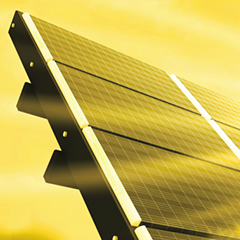The Organic PhotoVoltaics (OPV) shared research program addresses efficiency, lifetime and production costs for (near) future OPV applications. The balance of these three parameters depends on the envisaged application, but in the end, OPV should be able to compete somehow with Si PV in the future. We take a look at the notable collaborative work of the pioneering Solliance facility.
The growing interest in organic photovoltaics (OPV) is caused by their promise for low cost energy conversion. In order to have an impact on the power generation market on the longer term, OPV should combine high power conversion efficiency with low production costs and long term stability.
The Solliance OPV shared research program, a joint initiative of imec, ECN, Holst Centre and the Eindhoven University of Technology, together with its industrial partners, offers a complete set of skills and technologies to enable fast and efficient technology transfer to future OPV manufacturers.
Depending on the end-application envisaged and the estimated annual production for that application, Solliance developed a Cost of Ownership combined with a Life Cycle Analysis modeling tool to select the most appropriate materials, device lay-outs and production processes.
Starting from molecular/materials engineering and material choices, device and module optimisation, and using different production scenario’s, it will be explained how the Solliance OPV Program is able to identify and actually demonstrate OPV manufacturing routes that yield much better values for the final module efficiency, lifetime and projected production costs.
Preparation
OPV devices with high power conversion efficiencies (PCE) can only be reached by a combination of novel high performing materials and an optimum device stack, the latter consisting of the right layer thicknesses for optimal light capture in the photo-active layer, the right selective charge conductors at both sides of the photoactive layer and the most optimal and fine-tuned processing conditions. The Solliance OPV shared research program focusses on the development and testing of new high performing materials, the development of improved interlayers, new device designs and novel interconnection technologies to achieve high active area coverage.
Single junction solution processed OPV Cells
The OPV team of imec was able, within a collaboration of Solvay and Polyera to reach a certified PCE value of 9 per cent for a single junction inverted OPV cell design by using a novel p-type polymer semi-conductor. Novel interlayer processing based on the use of TiOx has allowed creating a very efficient inverted architecture in which parasitic optical absorption losses were strongly minimised. This architecture has in the mean time proven to be widely applicable on a broad range of active materials, polymers as well as evaporated small molecules, and recently has enabled to cross the 9 per cent efficiency barrier (internal result).
Instead of using a polymer absorbing and electron donor material, also small molecules were explored. So far, efficiencies as high as 8.1 per cent (internal results) were obtained.






























